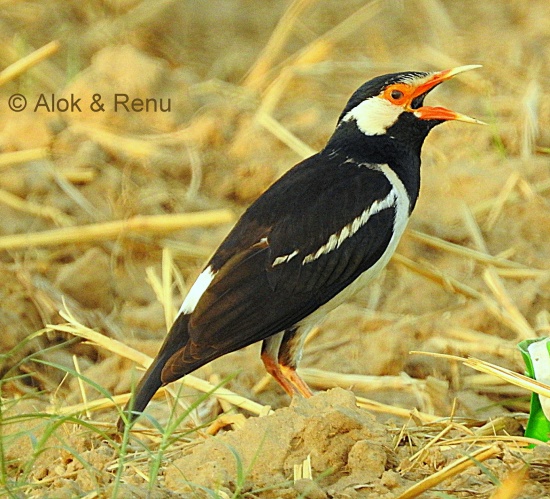(Imp sizes. References updated) |
Aloktewari (talk | contribs) (Image of immature.) |
||
| Line 20: | Line 20: | ||
Common in most of its range. | Common in most of its range. | ||
==Taxonomy== | ==Taxonomy== | ||
| − | [[Image: | + | [[Image:asian_pied_starling_alok_3.JPG|thumb|350px|right|Juvenile<br />Photo by {{user|aloktewari|Alok Tewari}} <br />[[Keoladeo National Park]], Bharatpur, [[India]], June-2017]] |
====Subspecies==== | ====Subspecies==== | ||
Five subspecies are recognized<sup>[[#References|[1]]]</sup>: | Five subspecies are recognized<sup>[[#References|[1]]]</sup>: | ||
| Line 42: | Line 42: | ||
====Breeding==== | ====Breeding==== | ||
| + | [[Image:asian_pied_starling_alok.JPG|thumb|350px|right|Photo by {{user|aloktewari|Alok Tewari}} <br /> Communal roosting shared with Bank Myna<br/>Basai Wetlands, Gurgaon, Haryana [[India]], Jan. 2015]] | ||
Breeds from February to October in [[India]], May to July in southeast [[Asia]], September to October in [[Java]]. A [[Dictionary_M-O#M|monogamous]] species, sometimes breeding in loose colonies. The nest is a large domed structure made of twigs, grass stems, rootlets, palm leaves and artifical material (like plastic bags). It's placed 5 to 15m above the ground in a tall tree, an electricity pole or a lamppost. Lays 4 - 6 eggs, 3 in [[Java]].<br /> | Breeds from February to October in [[India]], May to July in southeast [[Asia]], September to October in [[Java]]. A [[Dictionary_M-O#M|monogamous]] species, sometimes breeding in loose colonies. The nest is a large domed structure made of twigs, grass stems, rootlets, palm leaves and artifical material (like plastic bags). It's placed 5 to 15m above the ground in a tall tree, an electricity pole or a lamppost. Lays 4 - 6 eggs, 3 in [[Java]].<br /> | ||
A resident species with some local movements in extreme northwest of range. | A resident species with some local movements in extreme northwest of range. | ||
Revision as of 03:19, 12 July 2017
Alternative names: Pied Starling; Pied Myna

Photo by Alok Tewari
Gurgaon, Haryana, India, May-2017
- Gracupica contra
Sturnus contra
Identification
22cm (8½ in). A medium-sized Starling.
- Black and white plumage
- Creamish yellow bill
- Orange skin around eye
- White ear coverts and underparts
- Black throat and upper breast
- White scapular line and inner wing coverts in largely black wings
- Yellowish-brown legs
Sexes similar. Juveniles are browner than adults, their cheek patch is dirty white.
Distribution
From extreme eastern Pakistan to north and central India, southern Nepal, Bangladesh, Burma, southwest China, Thailand, Laos, Cambodia and on Sumatra, Java and Bali.
Introduced around Bombay, in Japan and in Saudi Arabia and the United Arab Emirates.
Common in most of its range.
Taxonomy
Subspecies
Five subspecies are recognized[1]:
- G. c. contra:
- G. c. sordidus:
- Northern Assam
- G. c. superciliaris:
- Manipur and Myanmar south to Tenasserim
- G. c. floweri:
- G. c. jalla:
Some authorities place this species in genus Sturnus.
Habitat
Cultivated areas such as ricefields, open lowlands, especially well-watered cultivated areas, reservoirs and parks and gardens. Mainly in the lowlands.
Behaviour
Forages on the ground, usually in pairs or small groups. In non-breeding season also in bigger flocks of up to 30 birds.
Diet
Omnivorous. Feeds on animal food, fruit, nectar, flowers and seeds.
Breeding

Communal roosting shared with Bank Myna
Basai Wetlands, Gurgaon, Haryana India, Jan. 2015
Breeds from February to October in India, May to July in southeast Asia, September to October in Java. A monogamous species, sometimes breeding in loose colonies. The nest is a large domed structure made of twigs, grass stems, rootlets, palm leaves and artifical material (like plastic bags). It's placed 5 to 15m above the ground in a tall tree, an electricity pole or a lamppost. Lays 4 - 6 eggs, 3 in Java.
A resident species with some local movements in extreme northwest of range.
Vocalisation
Call given by a small number of individuals feeding on Salvadora persica blossom and fruits, early morning.
<flashmp3>pied_starling_alok.mp3</flashmp3>
Listen in an external program
Recording by Alok Tewari
Bharatpur Keoladeo National Park, India, Dec.-2014
References
- Clements, J. F., T. S. Schulenberg, M. J. Iliff, D. Roberson, T. A. Fredericks, B. L. Sullivan, and C. L. Wood. 2016. The eBird/Clements checklist of birds of the world: v2016, with updates to August 2016. Downloaded from http://www.birds.cornell.edu/clementschecklist/download/
- Del Hoyo, J, A Elliott, and D Christie, eds. 2009. Handbook of the Birds of the World. Volume 14: Bush-shrikes to Old World Sparrows. Barcelona: Lynx Edicions. ISBN 978-8496553507
- BF Member observations
Recommended Citation
- BirdForum Opus contributors. (2024) Indian Pied Starling. In: BirdForum, the forum for wild birds and birding. Retrieved 24 April 2024 from https://www.birdforum.net/opus/Indian_Pied_Starling
External Links





